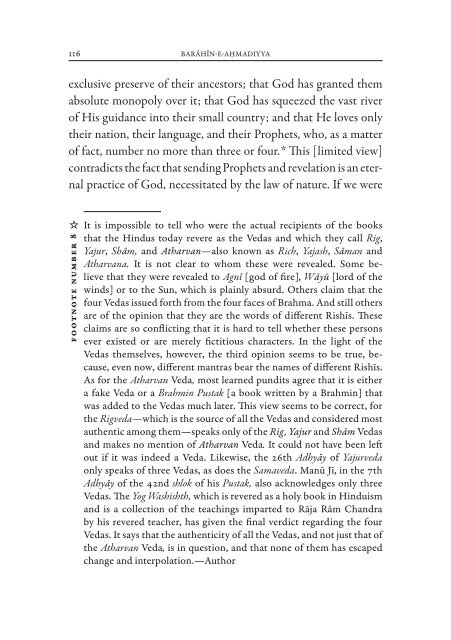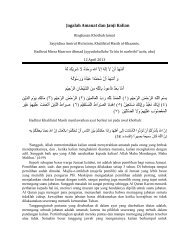You also want an ePaper? Increase the reach of your titles
YUMPU automatically turns print PDFs into web optimized ePapers that Google loves.
116 <strong>Barahin</strong>-e-ahmadiyya<br />
exclusive preserve of their ancestors; that God has granted them<br />
absolute monopoly over it; that God has squeezed the vast river<br />
of His guidance into their small country; and that He loves only<br />
their nation, their language, and their Prophets, who, as a matter<br />
of fact, number no more than three or four. ☆ This [limited view]<br />
contradicts the fact that sending Prophets and revelation is an eternal<br />
practice of God, necessitated by the law of nature. If we were<br />
☆ It is impossible to tell who were the actual recipients of the books<br />
that the hindus today revere as the Vedas and which they call Rig,<br />
Yajur, Sham, and Atharvan—also known as Rich, Yajash, Saman and<br />
Atharvana. It is not clear to whom these were revealed. Some believe<br />
that they were revealed to Agni [god of fire], Wayu [lord of the<br />
winds] or to the Sun, which is plainly absurd. others claim that the<br />
four Vedas issued forth from the four faces of Brahma. And still others<br />
are of the opinion that they are the words of different rishis. These<br />
claims are so conflicting that it is hard to tell whether these persons<br />
ever existed or are merely fictitious characters. In the light of the<br />
Vedas themselves, however, the third opinion seems to be true, because,<br />
even now, different mantras bear the names of different rishis.<br />
As for the Atharvan Veda, most learned pundits agree that it is either<br />
a fake Veda or a Brahmin Pustak [a book written by a Brahmin] that<br />
was added to the Vedas much later. This view seems to be correct, for<br />
the Rigveda—which is the source of all the Vedas and considered most<br />
authentic among them—speaks only of the Rig, Yajur and Sham Vedas<br />
and makes no mention of Atharvan Veda. It could not have been left<br />
out if it was indeed a Veda. Likewise, the 26th Adhyay of Yajurveda<br />
only speaks of three Vedas, as does the Samaveda. Manu Ji, in the 7th<br />
Adhyay of the 42nd shlok of his Pustak, also acknowledges only three<br />
Vedas. The Yog Washishth, which is revered as a holy book in hinduism<br />
and is a collection of the teachings imparted to raja ram chandra<br />
by his revered teacher, has given the final verdict regarding the four<br />
Vedas. It says that the authenticity of all the Vedas, and not just that of<br />
the Atharvan Veda, is in question, and that none of them has escaped<br />
change and interpolation.—Author<br />
Footnote Number 8




